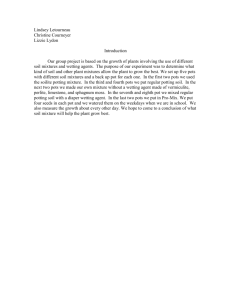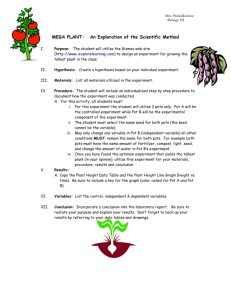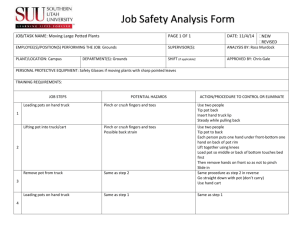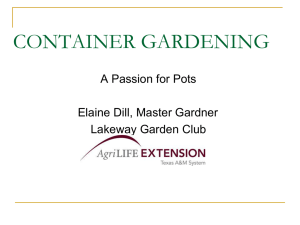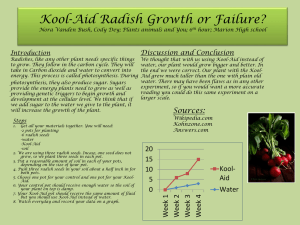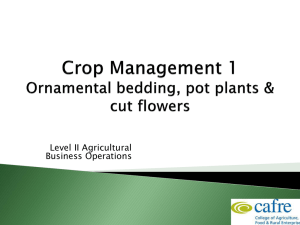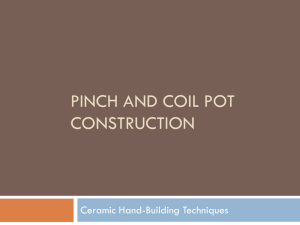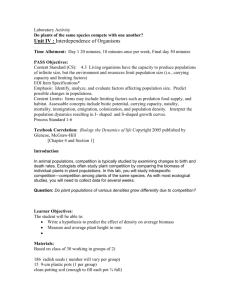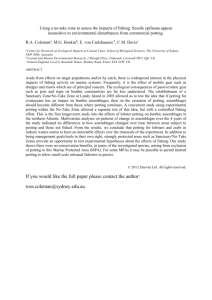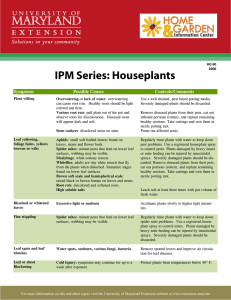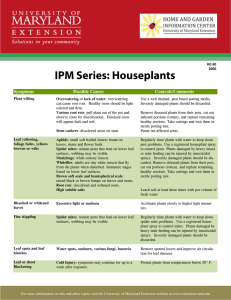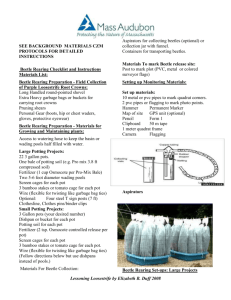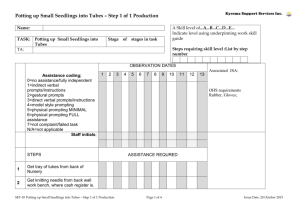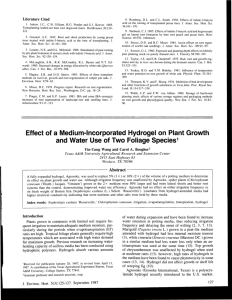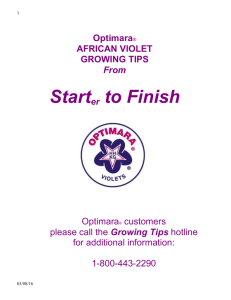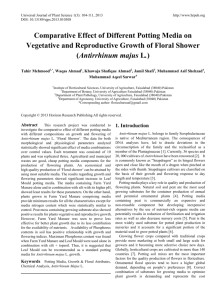Sample Letter 2 - 2015 Spring Fair
advertisement
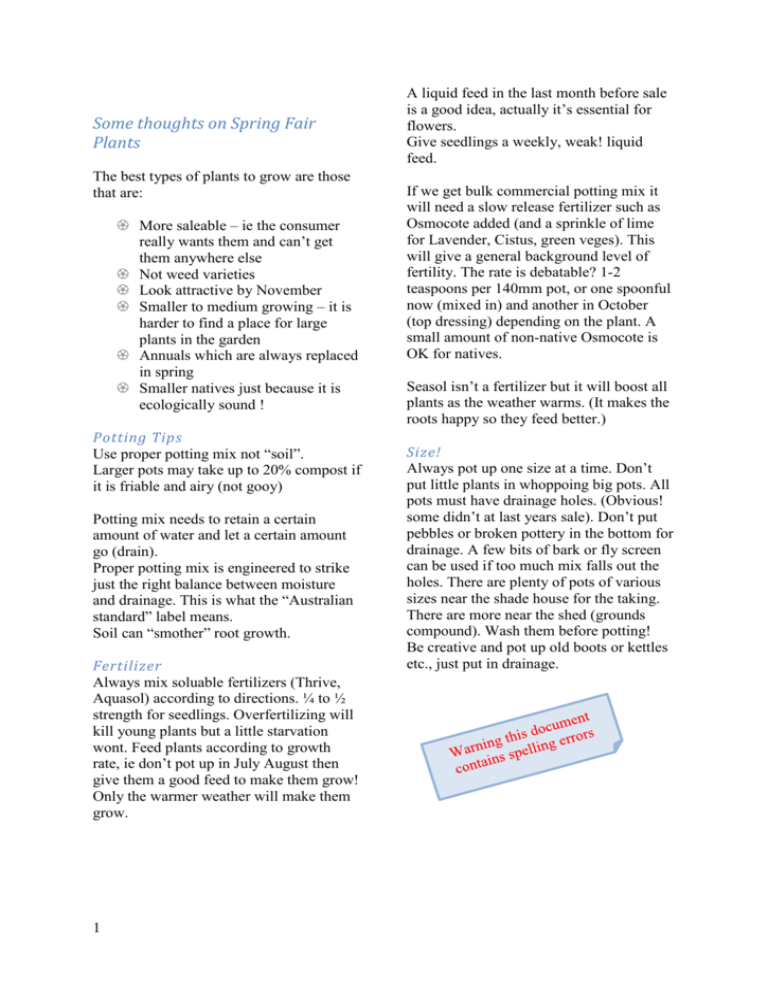
Some thoughts on Spring Fair Plants The best types of plants to grow are those that are: More saleable – ie the consumer really wants them and can’t get them anywhere else Not weed varieties Look attractive by November Smaller to medium growing – it is harder to find a place for large plants in the garden Annuals which are always replaced in spring Smaller natives just because it is ecologically sound ! Potting Tips Use proper potting mix not “soil”. Larger pots may take up to 20% compost if it is friable and airy (not gooy) Potting mix needs to retain a certain amount of water and let a certain amount go (drain). Proper potting mix is engineered to strike just the right balance between moisture and drainage. This is what the “Australian standard” label means. Soil can “smother” root growth. Fertilizer Always mix soluable fertilizers (Thrive, Aquasol) according to directions. ¼ to ½ strength for seedlings. Overfertilizing will kill young plants but a little starvation wont. Feed plants according to growth rate, ie don’t pot up in July August then give them a good feed to make them grow! Only the warmer weather will make them grow. 1 A liquid feed in the last month before sale is a good idea, actually it’s essential for flowers. Give seedlings a weekly, weak! liquid feed. If we get bulk commercial potting mix it will need a slow release fertilizer such as Osmocote added (and a sprinkle of lime for Lavender, Cistus, green veges). This will give a general background level of fertility. The rate is debatable? 1-2 teaspoons per 140mm pot, or one spoonful now (mixed in) and another in October (top dressing) depending on the plant. A small amount of non-native Osmocote is OK for natives. Seasol isn’t a fertilizer but it will boost all plants as the weather warms. (It makes the roots happy so they feed better.) Size! Always pot up one size at a time. Don’t put little plants in whoppoing big pots. All pots must have drainage holes. (Obvious! some didn’t at last years sale). Don’t put pebbles or broken pottery in the bottom for drainage. A few bits of bark or fly screen can be used if too much mix falls out the holes. There are plenty of pots of various sizes near the shade house for the taking. There are more near the shed (grounds compound). Wash them before potting! Be creative and pot up old boots or kettles etc., just put in drainage. Some herbs n vege to grow – ok in frost Parsley Oregano Tarragon Thyme Common Mint Peppermint English spinach Silver beet French eschallots, red onion, garlic Coriander Celeriac Rocket Mizuna Endive Marshmallow Lettuce, all different varieties Peas Other unusual onion varieties Flowers ok in light frost, or in trays outdoors but under protection, find a sun trap near a wall and cover when -3° or more predicted. Lobelia Dianthus Cornflower Snapdragon Alyssum Later when warmer and out of frost - buy seedlings and pot up in small pots Marigolds – French Tagetes – we have enough pot marigold at Orana to sink a ship Vinca (annual) Nasturtium Petunia Begonia With frost protection and by November ! Tomatoes and Chillies–try exotic varieties not available at usual nursery outlets Basil Beans Zukini and other exotic cucurbits Okra (loves the heat) 2 Perennials worth dividing or potting up as pups and self-seedlings African Daisy (Arctotis) or purple daisy flower, or Dimorphetica Gazania - pink/burghandy forms only Dieties (grassy look) take divisions Mondo Grass Penstemon Potato Vine- often sets seed look for little seedlings around base Coreopsis and Rudbeckia species- tall tough yellow daisy flowers Gaillardia Portulaca – or pigface many colours, roots at nodes, dig up stems with roots late winter and pot up Scabiosa – a real beauty if anyone can part with divisions Campanula species Succulants with special character and foliage colour, use attractive stones for mulch around base. AloeVera Lycnis coronaria Cheiranthus (Wallflower) Erysimum, closely related to above Nepeta (Catmints) Echinacea Nautica Monardia didyma (pineapple sage) Scented Geraniums Chrysanthemum varieties Lunaria (Honesty) Convolvulus maurtanicus Some grey foliage plants such as: Cerastium tomentosum – often called ‘snow in summer’ low border plant Helichrysum argyrophyllum – similar to above, good in pots Tanacetum sp and Artemesia sometimes roots by layering so rooted sections can be snapped off , trimmed and potted up Ferns for variety – can be divided. Doodia aspera Blechnum penna-marina Also don’t forget Indoor Plants – many can be divided sunny sill. 3 easily and kept on a If purchasing smaller plants from Bunnings or Magnet Mart to pot up – consider small native shrubs and groundcovers. Everyone can find a place for these in their gardens. Examples below: Correas – any and all Hibbertia Brachycombe –white one is special Rhodanthe anthemoides (white paper daisy) Grevillea Mt Tamboritha Hardenbergia Myoporum parvifolium Lomandra Kangaroo Paw Banksia, Callistemon, Grevillea for a larger choice Melaleuca fulgens Philotheca or Eriostemon Gastrolobium or Brachysema Croweas There are many useful landscape plants that can be bought from mass market sellers in small tubes or perennial punnets (available spring) and potted on, eg: Lavender Fushia Teucrium fruticans English box Escallonia Osmanthus Raphiolepis Cistus Salvias Photinia Arenaria montana Veronica ‘Oxford Blue’ Verbenas – bright colours Convolvulus cneorum Conifers! (Smargd) Think about growing what you would like to buy yourself. It goes with out saying ‘if it is easy to propagate, everyone probably already has it in their garden or doesn’t want it’. 4
